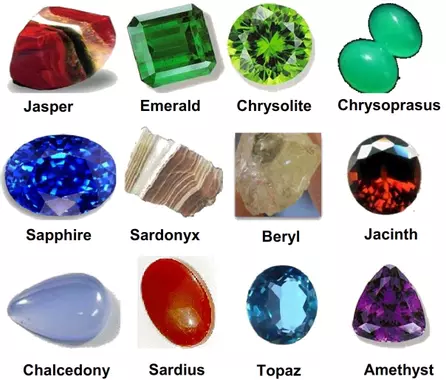The 12 gemstones referenced in our scriptures below have unique properties and represent the 12 Houses of Israel.
- Rev 21:19 | And the foundations of the wall of the city were garnished with all manner of precious stones. The first foundation was jasper; the second, sapphire; the third, a chalcedony; the fourth, an emerald;
- Rev 21:20 | The fifth, sardonyx; the sixth, sardius; the seventh, chrysolite; the eighth, beryl; the ninth, a topaz; the tenth, a chrysoprasus; the eleventh, a jacinth; the twelfth, an amethyst.
- Rev 21:21 | And the twelve gates were twelve pearls; every several gate was of one pearl: and the street of the city was pure gold, as it were transparent glass.
Article Link: The 12 Foundation Stones in New Jerusalem (Yasharalam)
(…heathen source, read with discernment & spit out the bones)
In the past century, it has been discovered that gems can be classified as either anisotropic or isotropic, and only recently have scientists discovered cross polarized light, which can be used to identify whether a gem is anisotropic or isotropic. When viewed in crossed-polarised light (similar to “pure” light), anisotropic stones produce a colourful array- reflecting all the colours of the rainbow, whereas isotropic stones lose all of their colour and appear black.
It’s interesting that, in Revelation chapter 21, there are 12 gems mentioned to be inlaid for decoration of the New Jerusalem, and ALL of these 12 gems are anisotropic gems, i.e., gems that can show colourful patterns under pure light…
Interestingly, neither diamond, rubies or garnets are mentioned, despite the fact that these group of gems are very very common! For instance, the precious stones are generally considered to be diamond, ruby, sapphire and emerald, with all other gemstones being semi-precious. Turns out, it’s because they are isotropic, when pure light passes trough them, there is no beauty at all…
“For wisdom is better than rubies; and all the things that may be desired are not to be compared to it.” (Proverbs 8:11)
What are the odds?
Of the 28 stones that are normally regarded as gemstones, only 16 are anisotropic. Since anisotropic behaviour has only been discovered in the last century (and John wrote Revelation almost 2000 years ago), the odds of 12 stones picked randomly being in that one group, is about 1 in 1,000! In fact, this analysis assumes that all gems have the same probability of being included, but this is not the case (as some gems are considered more precious than others). Hence, the actual probability is much much lower than 1 in 1,000 for naming all the 12 gems, that are all anisotropic gems, in the book of Revelation!
Keep in mind that there are a few assumptions being made here, i.e. the stones are a literal description of heaven (which I believe are) and that the light in heaven will be like “pure” light, which emanates through the gems…
Could it be possible that God, in choosing the stones for the foundation of the new temple, deliberately avoided stones that would lose their colour and instead chose stones that disperse light to produce brilliant rainbow effects?
“…and there was a rainbow round about the throne, in sight like unto an emerald.” (Revelation 4:3)
—
When is doubt, always look up the translation from Hebrew, for example the “diamond” translated below is not the same as the diamond of today.
- Exo 28:17 | And thou shalt set in it settings of stones, even four rows of stones: the first row shall be a sardius, a topaz, and a carbuncle: this shall be the first row.
- Exo 28:18 | And the second row shall be an emerald, a sapphire, and a diamond.
- Exo 28:19 | And the third row a ligure, an agate, and an amethyst.
- Exo 28:20 | And the fourth row a beryl, and an onyx, and a jasper: they shall be set in gold in their inclosings.
- Exo 28:21 | And the stones shall be with the names of the children of Israel, twelve, according to their names, like the engravings of a signet; every one with his name shall they be according to the twelve tribes.
- Exo 28:22 | And thou shalt make upon the breastplate chains at the ends of wreathen work of pure gold.
From IGI Gemblog: Identification using light behavior
In simple terms, the essential difference between a homogeneous body and a heterogeneous body is whether a beam of light will be broken into two beams after entering the gemstone.
For homogeneous gemstones: Light does not break down after entering the medium. It propagates with a fixed refractive index in all directions (single refraction). This light behavior is known as optical isotropy.
For heterogeneous gemstones: Light breaks down inside the gemstone and propagates with two different refractive indices (double refraction). Unless it comes from a special direction, light becomes decomposed into two polarized beams with perpendicular vibration directions and different propagation speeds. This light behavior is known as optical anisotropy.
—
Stones That Produce Negative Ions
Although called negative, the negative ions possess a lot of positive health benefits and in general are capable of creating positive emotional states. Let us see first what the deffinition of positive and negative ions is.
Physics tells us that positive ions are atoms or molecules that have lost one or more electrons, therefore having shortage of electrons. Negative ions on the other hand have gained one or more additional electrons, which, because of the negative elemental charge of the electron, make the system negatively charged as a whole.
In nature we have a delicate balance between negative and positive ions. For example, during thunderstorms the natural ratio of positive vs negative ions in the air can be disturbed very easily. A couple of hours before the weather storm front hits the area, the concentration of positive ions in the air is very high. During the storm and following the storm, the number of positive ions gradually declines, while at the same time the concentration of negative ions is increased.
Health Benefits of Negative Ions
Research has shown that positive ionization present during wind storms leads to weather sensitivity in people, such as irritation, exhaustion and health problems.
In contrast to exposure to positive ionization, the surplus of negative ions is associated with mood improvements, resistance to stress, and better general health. Some studies suggest that negative ions are biologically active and have a positive impact on the natural 24-hours cycle.
It is generally accepted that negative ionization has a positive effect on stabilizing the blood pressure, improving the function of the cardiovascular system, increasing the alkaline environment of the organism, accelerating physical recovery, strengthening the bones and improving the respiratory and nervous system.
The balance of negative vs positive ions is usually disturbed in offices, factories, and shopping malls where we encounter an excess of positive ions. Residential areas, mountains, parks, beaches, forests and springs are places where we have high concentration of negative ions.
waterfalls are best natural sources of negative ions Waterfalls are especially beneficial, having one order of magnitude higher concentration of negative ions than positive ones.
The Additional Function of Negative Ions
Negative ions have been found to help eliminate pollen, dust, and similar agents from the air: all that we cannot see with naked eye.
The good thing about negative ions is that they are not harmful even if their concentration is very high.
Natural Sources of Negative Ions
In nature, as we have already mentioned, beneficial negative ionization is created after storms and lightning. Negative ions are also produced by the ionization action of cosmic rays, and by the activity of the chemical element radon present in the earth’s crust.
In the ancient art of Feng Shui, negative ions are generated using indoor fountains.
Another natural source of negative ions is beeswax. When burned, beeswax gives off negative ions that purify the air and improve the mood. Beeswax candles are good sources of natural negative ions.
Natural salt is also believed to be source of negative ions.
Himalayan Natural Crystal Salt Lamp
Made from salt (NaCl) crystals from the Himalayan this salt lamp includes a 15-watt bulb, which gives an amber glow. Different bulbs may give different hues to the lighting area.
salt lamp is a nice source of negative ions
Although the salt lamps are somewhat controversial in their exact mechanism of ionization, there seems to be an overwhelming amount of testimonials about the usefulness of such crystal salt lamps. The functioning of the salt crystal lamp, obviously, cannot be compared directly to the mechanism of ion production in a typical ionizer. In addition, there are many beneficial properties that an ionizer does not have. For example, the color of the salt crystal can have a healing effect. The most common orange color facilitates a feeling of security, the yellow color encourages intellectual activity, while the red color is vitalizing and provides energy. Also, salt as a primal element of nature contains minerals and trace element that possess biological and biochemical activity.
Negative Ion Projectors
There is a class of devices designed to give off a flux of negative ions. Some are better than the others, and there are brands capable of producing ozone in parallel with ions. Here is a review of one device we found especially convenient.
Other Stones as Sources of Negative Ions
Tourmalines are stones that emit negative ions Tourmaline is a piezoelectric stone. This means that it can generate an electrical signal when pressure or strain is applied on the surface of the stone. In addition it is a pyroelectric stone, which means that temperature changes can also generate a weak electric current within the stone. Tourmaline also produces far infra-red radiation. All this is believed to be sufficient to convert moisture from the air to negative ions. Many believe that this natural and safe negative ion emission is the reason why Tourmaline is such a wondrous and beneficial stone.
Amethyst is another natural gemstone that is believed to offer similar health benefits to that of Tourmaline. The same argument – far infrared radiation – is stated for Amethyst.
Amethyst crystals are also believed to emit negative ions and can bring about similar benefits, including removal of toxic particles and free radicals, better respiration, and removing aerosol and dangerous chemical from the air.
Summary
While salt lamps do emit some negative charge, it is possible that the ion output is not too intense and that it doesn’t extend too much from the surface of the lamp.
Tourmaline, Amethyst, and similar crystals are believed to be able to spread negative ions, but here the effect is even less pronounced than with salt lamps.
If you are looking for really strong levels of discharged negative ions, you have two practical options: first, enjoy the natural negative ions produced during and after a thunderstorm, and second, use a corona-discharge ionizer that gives you even stronger levels of discharged negative ions.
SOURCE: https://www.sunnyray.org/Stones-that-produce-negative-ions.htm
Further Reading:
ARTICLE: Wifi Experiment (Brings Forth Death)
ARTICLE: HIRC Health



